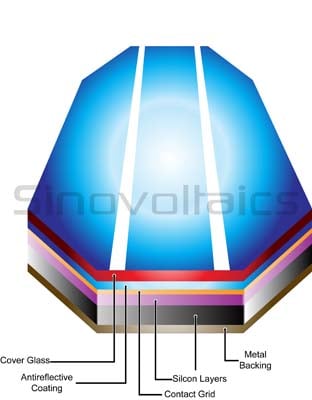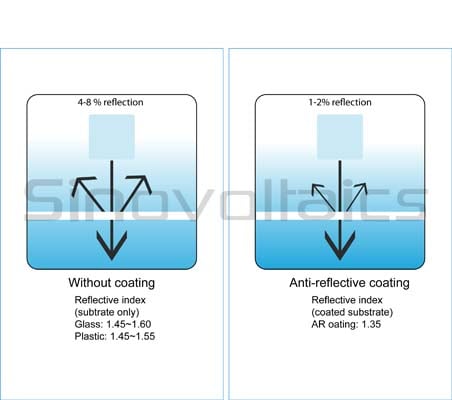Anti Reflective Coating: usage for solar panels
Anti Reflective Coating (or shortly: AR Coating) is a technical means to reduce reflection and increase light absorption of solar cells and thus increase its performance.
How is Anti Reflective Coating improving solar cell performance?
The Anti Reflective Coating on a solar cells helps to increase the amount of light absorbed into the cell. This anti reflective coating is very much needed as the reflection of a bare silicon solar cells is over 30%. For the thin AR Coating, silicon nitride or titanium oxide is used. When the anti reflection coating is left off, the cells will have a natural dark grey color. The color of the solar cell can be changed by varying the thickness of the anti reflection coating. Anti-reflection coatings on solar cells are quite similar to coatings used on other equipment such as camera lenses.  Reflective coating on thin film solar cell
Reflective coating on thin film solar cell
Anti reflective coating for solar panels
Nowadays not only the solar cells carry anti reflective coating, but such a coating can also be used on the glass surface (superstate) of solar panels. Anti reflective coatings on the solar panels glass will improve the light transmittance and therefore increases the overall efficiency of the pv module. Another advantage is that the glare from the glass will be reduced. Some say this allows the panels to blend in more easily with its surrounding. Also it allows the panels to be installed near airports (a panel without anti reflective coating might blind a pilot..). Anti reflective coating on solar glass
Anti reflective coating on solar glass

Yihua
on 07 Feb 2023vikas patel
on 21 Feb 2022Rayan
on 16 Feb 2022Jeremy
on 13 Feb 2022Madni Arslan
on 22 Aug 2021Jainam Shah
on 24 Mar 2021Deepali
on 11 Oct 2021Devendra Singh
on 17 Mar 2021Deepali
on 11 Oct 2021